Rockets with nuclear bombs for propulsion sounds like a Wile E. Coyote cartoon, but it has been seriously considered as an option for the space program. Chemical rockets combust a fuel with an oxidizer within themselves and exhaust the result out the back, causing the rocket to move in the opposite direction. What if instead, you used the higher energy density of nuclear fission by detonating nuclear bombs?
Detonating the bombs within a combustion chamber would destroy the vehicle so instead you’d do so from outside and behind. Each bomb would include a little propellant which would be thrown as plasma against the back of the vehicle, giving it a brief, but powerful push.
That’s just what a group of top physicists and engineers at General Atomic worked on between 1958 and 1965 under the name, Project Orion. They came close to doing nuclear testing a few times and did have success with smaller tests, exploding a series of chemical bombs which pushed a 270-pound craft up 185 feet as you’ll see below.
How Orion Works
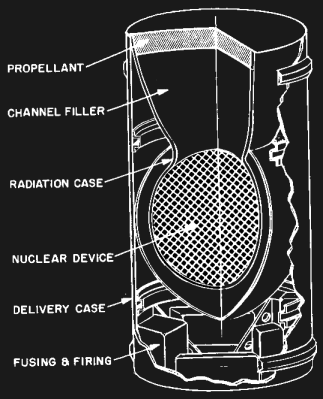
The rear of the spacecraft design consists of a pusher plate, so called because it’s what the propellant pushes against. Since each explosion is discrete, the propellant arrives in pulses. Two stages of shock absorbers cushion the acceleration of those pulses and dampen them so that the overall structure and the passengers in the payload section receive tolerable accelerations of only 2 to 4 g. Depending on the vehicle size, as many as 1000 bombs could be required to get to orbit and those would be stored in magazines and moved through the center of the craft where they are thrown out an opening in the middle of the pusher plate.
The bombs themselves are made in the form of shaped charges. The nuclear device is surrounded by a radiation case shaped to channel the initial blast toward the propellant. The propellant is in the shape of a flat disk so that the resulting plasma is cylindrical, optimizing its effect on the pusher plate.
Making Orion
Polish-American scientist Stanislaw Ulam is credited with having come up with the idea for using nuclear bombs for propulsion in 1946. Shortly after Sputnik in 1957, theoretical physicist Ted Taylor decided to turn the idea into reality and initiated Project Orion at General Atomic, a division of General Dynamics. Taylor’s passion was making things which explode and specifically making smaller and smaller nuclear bombs, just what Orion needed.
Getting funding for Project Orion was always difficult because none of the branches of the military could find a military use for it and NASA, a civilian organisation, had its own program for large spacecraft. They did manage to get some funding and support from ARPA, the US Air Force, the AEC (Atomic Energy Commission), and to a lesser extent, NASA.
Many in the Air Force and later, NASA, doubted that a craft could be lifted using bombs and so a flying model of some sort needed to be built to at least prove the concept.
The Flying Model
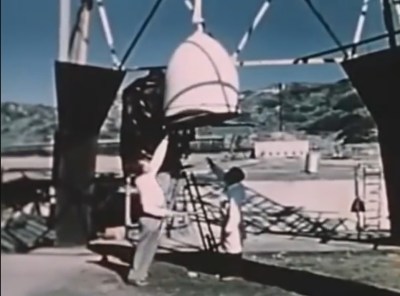
General Atomic never got permission to do testing with nuclear bombs, though a few times they came close. Instead, they did a series of tests using chemical explosives on a mesa near San Diego. These tests are detailed in the book Project Orion: The True Story of the Atomic Spaceship by George Dyson.
The purpose of the first test was just to prove that you could detonate a high-explosive charge near a structure without damaging it. Called Spaceship Number One, it consisted of an aluminum pusher plate with three stainless steel mixing bowls purchased from a local supermarket bolted on. Around 60 grams of C-4 was suspended 10 inches underneath. The result was a few scared animals including a skunk which sprayed back but no harm to the test device.
More tests followed at Point Loma, San Diego, California in 1959. Initially, they were tethered, starting with a one-foot model and then a series of one-meter models, all with a single explosive suspended below them.
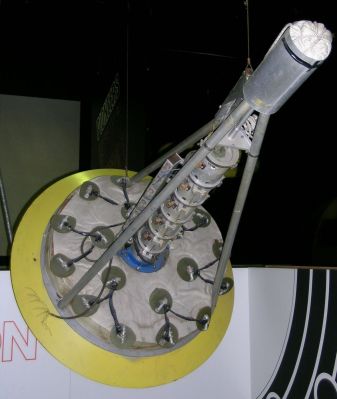
An amendment to their ARPA contract gave them permission to try for a free-flying model, which they achieved in just five months. Called the “Hot Rod”, it was one meter in diameter, weighed 270 pounds, and used five 2.3 pound charges. Each charge consisted of a grapefruit-sized ball of C-4 shaped by hand and contained in a coffee-can-sized canister and cushioned with polystyrene. They were ejected from the middle of the pusher plate using nitrogen gas. Shock absorbing foam held a miniature pusher plate to the bottom of each canister to protect it from the previous blast.
A combination of electronics, mechanics, and pneumatics controlled the timing and ejection and made sure that the charges didn’t explode if there was a jam or the if the craft crashed. Each canister was connected to an umbilical cord which uncoiled as the canister dropped. When the canister reached the end of the cord, a switch discharged a capacitor which powered a detonator, igniting the PETN high-explosive in the cord which then ignited the C-4. The detonation of the final charge triggered a shotgun shell which ejected a parachute from the nose for a soft landing. As an added safety feature, bleeder resistors across the capacitors made sure the capacitors discharged within fifteen minutes.
At first, it wouldn’t rise. They fixed this by putting about a pound of gunpowder in a tub and launching it from there. You can see this initial explosion in the video below. That was followed by a series of flights with various mishaps such as an excessively damaged shock absorber, jammed canisters, and charges failing to detonate. But November 14, 1959’s notes by Brian Dunne reported,
Flight successful in all respects. Height of rise about 185 feet. Parachute deployed at peak of trajectory. Model landed undamaged.
The results didn’t prove that a nuclear bomb propelled ship would work but did convince many that bombs could be used for more than just blowing things up.
Orion Spaceships
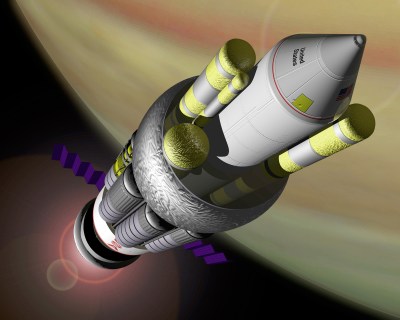
Led by theoretical physicist and mathematician Freeman Dyson, a great deal of theoretical work and simulations were done for the actual spacecraft.
One reference design was for a 4,000 US ton (3.6 million kg) ship utilizing 2,600 bombs and capable sending a 1,600-ton payload to Earth orbit and 800 tons to Mars orbit and back. Specific impulse (Isp) is a measure of how effectively thrust is produced from a given quantity of fuel. The Saturn V rocket with its chemical fuel had an Isp of 263 seconds whereas the 4,000-ton ship’s Isp with its nuclear detonations was 4,000 seconds. Each bomb’s yield at sea level was 0.15 kilotons (equivalent to 0.15 kilotons of TNT) and 5 kilotons in vacuum.
The 135-foot diameter pusher plate weighed 1,000 tons. To withstand the onslaught of plasma the surface would gradually wear away, or ablate. One plan for avoiding this was to use a sacrificial coating of oil or grease which would be either applied to or pushed through the pusher plate.
The payload/passenger section was unlike that of your normal spacecraft where every effort is made to minimize mass. Instead, it was intended to be built like a submarine using steel and with all the comforts passengers could desire.
Radioactive Fallout
What about the fallout from detonating so many nuclear bombs to get off Earth? To avoid that, chemical rockets would be used to boost Orion to above the atmosphere. However, the bombs would still detonate within the Earth’s magnetosphere and the fission products would slowly spiral down to the ground along the magnetic field lines. Rough estimates were that around 10 people would die from the radiation per flight. Later work on neutron bombs at the Lawrence Livermore National Laboratory later brought this estimate down to 1 person, still considered unacceptable by many.
The End Of Orion
Project Orion ended for two reasons. One was the difficulty in finding a home. Despite creative efforts to find a military use for it, none could be found which satisfied the various branches of the military. Meanwhile, NASA had its Saturn V rockets and its goal of reaching the Moon.
The second reason was the Eisenhower-Khrushchev moratorium on nuclear bomb testing between October 31, 1958 and September 1, 1961, and finally the 1963 nuclear test ban treaty still in effect today. Despite efforts to do so, all attempts to distinguish testing nuclear bombs for destructive use from testing for spacecraft propulsion failed to keep Project Orion alive. On June 30, 1965 the project was officially terminated.
If this form of nuclear propulsion sounds crazy compared to chemical rockets then perhaps you should check out our review of the book IGNITION! An Informal History of Liquid Rocket Propellants which shows that rocket fuel isn’t to be taken lightly either.

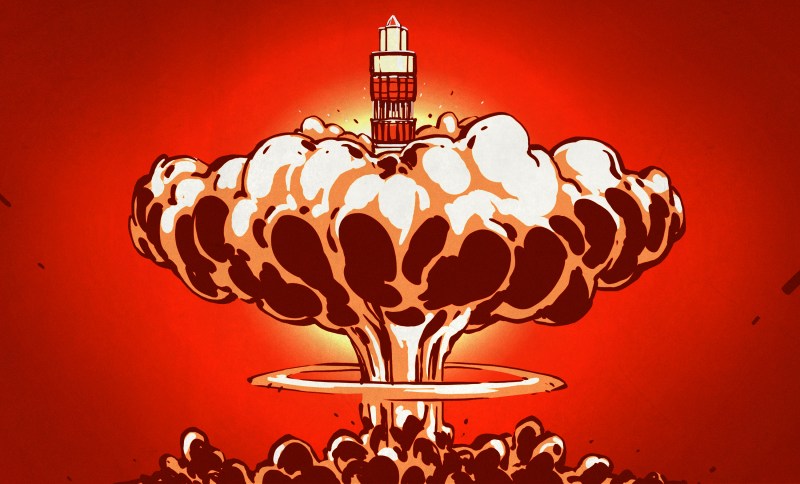
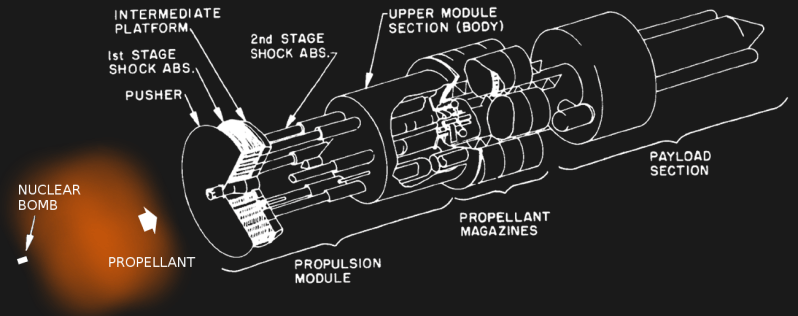













Fwiw, for a while (lack of research on my part) I thought Orion was the only nuclear-powered rocketry application but as it turns out there were 2 – Nuclear Pulse Propulsion (Orion) and Nuclear Thermal Propulsion, basically a semi-traditional uranium nuclear reactor using gaseous coolant – Hydrogen being the preferred – as the propellant. NERVA/NRX/KIWI are keywords for the latter, and NASA Marshall + Babcock & Wilcox are bringing NTP back as of Aug 2017.
https://www.youtube.com/watch?v=b18HtG0DOCM
Superheat H2 gas by passing it through a reactor and raise it to over 3000K out the bell housing and you can get crazy Isp (specific impulses) compared to chemical rockets. At least 900 seconds of Isp without really trying that hard, and it can “go up” from there.
Dr. James Dewar wrote a couple books, one of which I was able to obtain via amazon, “The Nuclear Rocket” which deals with this subject (mostly from a policy implication point of view, options for architectures, etc).
In the afterword on IGNITION the author gives his opinion that Nuclear Thermal Propulsion would be the propulsion method of the future (and our ticket to Mars). I worry that, given the public outcry about launching even the small amount of radioactive material in the RTG that powered the Cassini, that this won’t get off the ground (so to speak) for political rather than technical reasons.
That’s why one would launch from international waters.
Or not originate from Earth at all. There’s uranium and thorium on the moon in concentrations comparable to the Earth’s crust. It would be nice to use these miracle engines for orbit-to-orbit jaunts, and keep using pitiful chemical rockets just for resupplying crew and other things from Earth that we can’t find or make in space.
Once in space one can build a giant rail gun to throw things around. Or lasers to power solar sails.
Dr. Dewar’s example from his Nuclear Rocket book is a bit odd to me but addresses this concern – Launching from ground involves taking the payload up in a large aircraft (C5A is mentioned in the book), putting the airplane on a ballistic course over water to 10mi altitude and dropping it, some SRBs on the sides launch the rocket to 20mi as the nuclear reactor fires up (while the airplane drops and returns to land), then the NTP system boosts to LEO, delivers payload, drops to the ground in highly shielded and hardened capsule, reactor is recycled/reused. A separate system of “space tugs” in orbit would shuttle payloads around between Earth/Moon/Mars et al.
Personally I see the latter, the “space tugs”, as being the most lucrative application for NTP in the next 50 years, but the former (launching from ground) is the one requiring the most resources. Perhaps in a future scenario we can have nuclear-derived hydrogen+oxygen fuels powering our chemical heavy lift rockets so the carbon impact of rocketry is minimized (for those concerned about GHG impacts).
One of the main points behind using aircraft to launch a nuclear rocket is to reduce the facilities costs of doing so – the nuclear rocket should in theory be quite a bit smaller than an equivalent heavy lift chemical rocket, and the critical facilities involve handling LH2 and momentarily handling nuclear materials when the reactor arrives for assembly, but in theory you could outfit a number of airfields to support this and the airfields need not deal with hot exhaust gases/plumes since you’re launching over the ocean.
An RTG is radioactive when launched, a Reactor is not (until its turned on), public outcry would be baseless in that regard.
Every nuclear reactor I’ve ever heard of is full of uranium or plutonium. That’s quite radioactive.
lol
years ago, at the lengedary “Robbies”, down at Queenstown in Adelaide, amongst all the “stuff” was radiology treatment machine
when we mentioned it was possibly radioactive, Robbie said “isn’t that only when it’s turned on?”
we avoided that corner from then on
It depends what you mean by ‘nuclear’: nuclear thermal rockets are fission-based, whereas nuclear pulse propulsion would be fusion-based. The difference isn’t trivial, obviously, as the energy density of the two fuels are quite different.
“and you can get crazy Isp (specific impulses) compared to chemical rockets. At least 900 seconds of Isp without really trying that hard, and it can “go up” from there.”
A specific impulse of 900 seconds is only twice as high as the SSME. And I’m not sure about “go up from there” – pretty much everyone generically lists “twice as efficient” as the NTR benchmark.
Don’t get me wrong, a factor of 2 improvement in specific impulse is a big deal, but I’m not sure I’d call it “crazy.” It’s not clear that a nuclear thermal rocket would make sense compared to nuclear electric propulsion, for instance.
Ok fair enough, 900 isn’t crazy, but one of the more extreme cases of NTP I’ve heard is 8000 seconds – using gaseous uranium fuel with probably some future unobtanium material for containing the reactor. I heard Dr. Dewar mention this on “The Space Show” podcast once. I look at it as “as good as it can get”, and that is pretty darned good.
Main point being, if there’s any rocketry tech out there that can make truly dramatic improvements over what we have now, nuclear is it. Same goes with civilian power and industrial power generation IMO. Folks have a huge hangup over anything nuclear these days, and while it’s justified to a certain extent, we’ve taken it far beyond rational. A 2nd atomic age is due once cooler heads prevail.
Nuclear electric is basically where the “cooler heads” would end up. Closed-cycle nuclear thermal just isn’t that big an improvement over chemical, and open-cycle nuclear thermal is an engineering, environmental, and medical nightmare. This isn’t *terribly* surprising since nuclear thermal is just basically heating the hell out of hydrogen, and heat is a crappy way to get exhaust velocity since you have to avoid everything melting. Whereas with nuclear electric, you can just pump all of the power into insane-level electromagnetic fields to get crazy high exhaust velocities, and not have to worry about structural issues. You just have to worry about making the thruster work for a long time, and that, you can do on the ground (which is what many groups are working on now).
As long as governments can find ignorant engineers who are willing to design nuclear power plants on the coast in tsunami prone areas, and built the thing in a cellar instead of on poles or a raised island I’m with the nay sayers.
As long as polititians do not de-commision worn out nuclear plants which are long overdue and replace them with modern plants which are orders of magnitude safer and generate less radio active waste i’m with the nay sayers.
In the mean time the price of solar cells has dropped to about the same price as any other regular roof covering, but new houses are still not designed & built with the roof tilted the right way and completely made out of solar cells? Why?
Solar is not a complete solution untill we’ve figured out a way to store the energy efficiently, but Solar is almost free if it is integrated properly in the design of new houses.
If I were to design my own (free standing) house, I would also extend the roof a meter or so over the walls, for more room for solar cells. 200 years ago they did something similar to keep the clay or wooden walls of buildings dry from rain so they’d last longer.
I’ve always found those overhanging roofs beautifull, and now we have a good reason to build like that again.
Instead in the citiy I live they waste very precious ground even within the city’s border to build a solar farm on the ground ??? And this is in the Netherlands (Breda), a small country with 17 million inhabitants, where every square meter of ground is precious.
I think you’re thinking of open-cycle nuclear thermal rockets. You still use hydrogen as the propellant, but you compress and contain it around the (gas) core of the reactor magnetically and let it spew out the back (along with tons of radioactive crap). There’s not really a good use case for those, because even though they can get you from one spot to another *really* fast, you need a giant freaking spaceship to use them since you have to stay way the hell away from the plume. Like, hundreds of meters away.
The awesome Atomic Rocket site describes them as a “full-blown honest-to-Heinlein atomic rocket, spraying glowing radioactive death in its exhaust” which I always liked.
The reason there’s not much of a use case is that the only good reason for a super high specific impulse is to reduce the transit time to reduce the radiation exposure – but a ship like this would need to be huge in order to have a lower radiation exposure overall, increasing the overall mass and reducing the efficiency again.
Remember that a factor of 2 for the efficiency increase per unit mass of your fuel is going to exponentially decrease the mass of fuel required meaning you’d have to carry significantly less fuel.
Compensated by a heavy reactor.
And the larger tank capacity needed, since pure hydrogen is lower density than the hydrogen/oxygen mix in a chemical rocket. So equal weight fuel means bigger tanks. NASA’s nuclear thermal rocket designs basically typically ended up with factors of 2 overall delta-v improvement.
Thanks for the link, I love the video.
From the transcript of the video (click on “…” symbol and “open transcript” button).
“for the first time men from Earth will set foot on another planet. For the return trip the module is lifted by chemical power back into a Mars orbit where it docks with the main space vehicle the men transfer to the main craft and jettison the module meeting it in an orbit around Mars”
It is funny to think how a 1968 NASA video talks about men only, 50 years ago no women were envisioned as being physically able to work in space.
55 years ago a woman orbited the earth 48 times – solo. Not everybody thought women couldn’t work in space.
with NERVA, KIWI and now VASIMIR, why use hydrogen?
why not something heavier like diesel?
you wouldn’t have the hassle of cryogenic tanks, diesel heated up really hot would provide more thrust.
am I missing something?
Thermal velocity.
Your thruster heats things up to a given temperature (as high as the materials can allow), which means the exhaust velocity is given by the thermal velocity of the material. Lower mass, higher exhaust velocity, which means higher specific impulse.
In a real design you could imagine that there *might* be a better fuel to use due to structural concerns, but rockets are almost all fuel – you’d need a lot of weight reduction to counter the lower specific impulse.
organic compounds break down at high temperatures, there is a lot of hydrogen (as well as oxygen, carbon and nitrogen) in “fuel oil”.
possibly water might work, but then you’d have to heat it, does diesel freeze?
Diesel #2 gels below freezing.
The whole point of these engines is to gain more specific impulse, not thrust. As far as propellants go, the lightest atoms work best. They get a higher exhaust velocity, therefore better Isp. Hydrogen is ideal for this, except for how frustratingly low its density is. You can store it as a liquid with cryogenics of course, but you could also keep it as a gas at the expense of much larger and heavier tanks. It’s a bit of a dilemma.
There are concepts which use water instead, such as Zubrin’s nuclear salt-water rocket.
http://www.projectrho.com/public_html/rocket/enginelist.php#id–Nuclear_Thermal–Gas_Core–Open_Cycle–Nuclear_Salt_Water
Whether or not a plenum could contain this is dubious.
A fuel mixed with Boron would provide better thrust. In “Ignition!” there’s a chapter devoted to failed experiments with Boron containing fuels. In liquid fueled rockets, Boron was a big problem. It caused sticky, tar-like buildup everywhere inside. Combustion chamber, throat, and nozzle. It would build up despite the high temperature and high speed exhaust, eventually choking off the throat. If fuel and oxidizer weren’t cut fast before the throat got choked down too much, KABOOM.
So after trying everything they could think of, Boron was crossed off their list of things to try. Would have done wonders for rocketry if they could’ve invented a non-coking Boron containing fuel.
But in a thrust engine that doesn’t combust the fuel, Boron would be an ideal additive to add mass to the reaction mass. No problems with it tarring up the engine’s innnards.
You’re confusing “fuel” and “propellant.” Boron compounds are useful in chemical burning as a fuel because they have high specific energy, but as you noted when you burn them you get lots of crap.
But here, the hydrogen is just being used as propellant, so literally the only thing that matters is the mass of the molecules (or atoms, if the gas dissociates) being heated.
There’s quite a few nuclear propulsion concepts which came to various stages of development. Only solid-core NTR was ever tested, as far as we know.
There was project Medusa, which was like an Orion which detonated the nukes ahead of the ship inside a huge parachute-shaped sail instead of behind a tungsten shock absorber plate. There was Zubrin’s salt-water rocket, which housed fuel and propellant in the form of uranium salts dissolved in water. The geometry of the fuel tanks kept a critical mass from happening until it was pumped into the combustion chamber, where a continuous nuclear detonation would take place–as crazy as that sounds. There were liquid-core and gas-core nuclear thermal rocket designs, of both open-core and closed-cycle arrangements. Those theoretically have far better Isp, but trying to maintain a nuclear reactor in a fully liquid or even vaporous or plasma state is obviously very difficult. You’re pushing the thermal handling capabilities of any and all solid matter at that point.
If you want to see something truly scary, look up project Pluto. It’s not for space propulsion, but it’s an open-core fission ramjet which was designed to autonomously fly circles over Soviet Russia for ages, vomiting raw fission byproducts out the back and irradiating an entire continent. It would be so radioactive that its entire structure would have to be made of gold-plated tungsten, which would glow white-hot while in operation from a combination of x-ray heating and compression heating caused by its hypersonic speed.
There’s fission fragment rockets, which use the nuclear fuel itself as propellant. One concept uses a tiny amount of positrons to catalyze nuclear fission on the surface of a large sail, misting the uranium-impregnated surface with antimatter to send the split atoms flying off at relativistic speeds. The thrust is extremely slight, like an ion engine, but the Isp is ludicrously high.
That’s just fission, and only fission used directly for propulsion at that. There’s also nuclear-electric concepts, where a traditional nuclear reactor would generate power to drive ion or MHD thrusters. And there’s the whole highly-speculative world of fusion, such as project Daedalus, ridiculous Enzmann starships which push asteroid-sized chucks of frozen deuterium fuel around, and tons of magnetic mirror and inertial confinement concepts. It’s interesting to note that for fusion propulsion, you don’t necessarily need to break even with generating power, which is where we always fail with fusion reactors. The objective is to accelerate the exhaust as fast as possible for high Isp, not to have a power surplus. So you can generate the deficit with a traditional nuclear reactor and still get by with tremendously inefficient fusion and poor containment.
Check out tons of concepts here:
http://www.projectrho.com/public_html/rocket/enginelist.php
Interestingly the Russians claim they have a nuclear-propelled cruise missile in testing. A recent Putin speech included video of an unusual cruise missile from chase planes. While Project Pluto had multiple warheads the Russian design appears to be a single warhead device designed to fly long routes to evade conventional defenses. There have been unexplained spikes in detected radionuclides in Europe that could be from ditching test vehicles.
JFK saw a mockup of the project, with guns on it, put on by the AirForce and nixed the whole thing right away. If they had displayed an exploratory spaceship instead of a battleship, the whole thing may have gotten off the ground.
https://en.wikipedia.org/wiki/Project_Orion_(nuclear_propulsion)
“Oh, those are not guns, Mr. President! They are small manually controlled reaction motors that slow down or alter the course of the spacecraft by expelling small heavy ignots with hot gasses!”
Very interesting article. Just like the staircase program in “Death’s End”, the 3rd book of the ‘Three Body Problem’.
I won’t tell anymore because … spoilers.
It is a really good read. And finally am multi-book story that has all books released. Not like my last 2 reading attempts: Game of Thrones and the Kingkiller Chronicles
Just to add a little confusion to this, the current space capsule being tested/built by NASA is also called Orion.
https://www.nasa.gov/exploration/systems/orion/index.html
King David’s Spaceship by Jerry Pournelle uses a variation of of explosive propulsion [I’d give more details, but it would spoil the plot] – Think going from pre-victorian to spacecraft in one generation.
They used a nuclear Orion craft to fight the aliens in the book Footfall. It’s a pretty good story overall too.
After seeing “Independence Day”, I found myself thinking they could make a Footfall movie. Then I realized that Hollywood couldn’t make a decent Footfall movie, given the amount of manliness in it, and the idea of a kick-ass weapons platform powered by actual nuclear weapons literally scaring the shit out of the aliens. What if people got ideas?
[Footfall came out in a Strategic Defense Initiative timeframe, of which Pournelle was a fan.]
I saw a BBC Horizon TV program about project Orion a good few years ago. And they were trying to add as much weight as possible, they were ever talking about having old style barber chairs and concrete floors in the spaceship!
https://i.ytimg.com/vi/qa7Dk5aDqNg/maxresdefault.jpg
well mass not weight.
Probably this BBC documentary – https://www.youtube.com/watch?v=UEtaQpHBP4U
That look about right.
Kenneth Brower’s “The Starship and the Canoe” from 1980 covers one of this, though in a non-technical form. It also covers making kayaks, some quite large, with modern materials. I’ve read it a bunch of times since it came out in paperback, though I’ve never seen a used copy.
George Dyson, Freeman’s son, built the kayaks. He much later wrote a book about Project Orion, but last time I looked, it’s still out of print.
Michael
https://youtu.be/kZzBd41NuZw
Great project, and the book mentioned by G. Dyson, which I read.
I always wondered: if this was built with the best chemical explosives only (instead of nuclear bombs), would it be more efficient (more ISP) than our current rockets?
Wasn’t the lunar rocket in Tintin nuclear-powered?
3 comments:
1. This will probably work.
2. This is really impractical. You could write a book on the reasons why you wouldn’t do this.
3. Although you can get awesome thrust for a trip to Mars, you can’t go interstellar. Although the energy density of plutonium is way higher than kerosene, it’s nowhere near high enough to take a vessel to even c/100.
Falls under the “awesome, but impractical” trope.
https://tvtropes.org/pmwiki/pmwiki.php/Main/AwesomeButImpractical
Nuclear powered get engines were also a thing.
https://upload.wikimedia.org/wikipedia/commons/thumb/e/e4/HTRE-3.jpg/220px-HTRE-3.jpg
There’s still talk on that, using a helium cooled thorium reactor, with a helium to air heat exchanger. The heated air would blow through what would normally be the combustion section of a turbofan engine. Like with normal bypass turbofans, most of the thrust would come from the fan section.
The ‘problem’ with such a setup is the thing would have to run all the time. Switch the heated air flow to vents when on the ground. As a bonus, hangars would need no other heat source in winter, and the airflow could be routed through a turbine to spin a generator for powering air conditioning in summer. Any time the plane would be parked it could be generating electricity. Still earning money when parked, unlike fuel burning or battery powered aircraft.
You know I’m surprised none of the Fallout writers ever used any of these ideas. It all fits perfectly in that universe.
I love this idea, but I’m basically a mad scientist at heart.
The nuclear technologies targeted at flying things within our atmosphere have had plenty of interesting development as well:
The USA and USSR both had equally unsuccessful projects to build nuclear powered aircraft. Project Pluto and its extremely scary nuclear powered missile is probably a good benchmark for just how nuts you can get with nuclear technology.
https://en.wikipedia.org/wiki/Nuclear-powered_aircraft
https://blog.seattlepi.com/americanaerospace/2010/07/12/the-missile-from-hell/
http://www.vought.org/products/html/slam.html
Very recently, the Russians actually announced that they’d built and tested a new nuclear-powered missile design:
https://www.npr.org/sections/parallels/2018/03/01/590014611/experts-aghast-over-russian-claim-of-nuclear-powered-missile-with-unlimited-rang
General Electric’s direct cycle Aircraft Nuclear Propulsion is of particular interest to me. My great uncle Bernard H. Duane worked on the project and I have a few of his papers on reactor theory for the ANP. Regrettably I didn’t know about this until after his death. Fortunately the USAF put together a 390 page document on the project – https://media.defense.gov/2014/Oct/14/2001329848/-1/-1/0/AFD-141014-032.pdf
The concept of Orion seems kinda flawed — I think it would only work in the atmosphere (and not in space) since it relies on absorbing the shock wave from a nuclear detonation. But the shock wave we see in atmospheric detonations is the outrushing of air from the heat of the explosion. In space the nuke only creates huge amounts of heat and high-energy electromagnetic radiation. I suppose you could try to ride that, but it would be easier to ride something less energetic and more manageable. Having said that, the bomb casing would be vaporized and rush outwards — I suppose you could harvest some impetus from that, but not much in the scheme of things. Perhaps you could make really massive casings to be vaporized?
Good point. That’s what the propellant is for. See the diagrams at the beginning of the article.
I should read more carefully.
Somehow during the era of Project Orion someone had the bright idea that it is not a good idea to design cheap and small atomic bombs and build them by the thousands. This has something to do with those terrorists which are still walking around here and there.
All this radiophobia is making me gag. Potential “kills” from radiation exposures well below acute radiation sickness is based on the false linear no threshold radiation effects assumption. Get with the program. There is no evidence that low level radiation causes ill effects and it many cases can be beneficial, ie, Radiation hormesis. There is no future with plans based on ignorant effects both good and bad.
this idea popped into my head over a decade ago,(i mean it was like this little movie that literally just popped into my head and started playing, whilst I was taking a walk in the country) and in my imagination of events, the initial occupants blasted off as Earth Asians but the Nuclear Propulsion evolved them into what I guess you could call: Asian Aliens.
Another SciFi book series that uses some Orion drive ships is “Plague Wars” by David VanDyke. Large chunks of the Australian outback get nuked launching them. But better that than the human species getting mostly exterminated then the rest bred in captivity to be used as hosts for the aliens that “blend” with other species, wiping their minds in the process.
After the Plague Wars series is the Stellar Conquest series. The first book of that one is pretty much a single space battle across a solar system. No FTL so things take a while.
TBH this project is one of my biggest dreams/disappointments. Being able to throw real mass into the solar system in the 70s would have changed so much, I used to have posters of the Orion blueprints, but I just kept getting mad looking at them.
I always thought the The Rolling Stones referenced the technology in their song “2000 Light Years From Home” –
“Sun turnin’ ’round with graceful motion
We’re setting off with soft explosion
Bound for a star with fiery oceans
It’s so very lonely, you’re a hundred light years from home
Freezing red deserts turn to dark
Energy here in every part
It’s so very lonely, you’re six hundred light years from home”
Ranks up there with dimethylmercury or dimethylcadium for rocket fuel. Then again, there may be some method to make a more clean nuclear reaction with the correct amount of nucleogenesis materials to cause the products to be less radioactive.
Wow… it’s as bad as having nuclear plants above ground or not underwater or on floatilla’s. I think all the nuclear power plants can be made into submarine modules to have more dampened “catacomb” storage areas to dampen the effects of natural and man made disasters. I need to advocate this submarine nuclear power plant module system idea more since seems to be way not dumb idea to implement more clean energy sources that can be distributed easier. I’ve never seen anyone else advocate the design either.
Technically, there seems to be brain damaged systems leadership issues with not only propellants… I think like aircraft can be refined to have safer hover vectored based on trajectory emergency rocket assisted landings as well as steam or even electromagnetic launch and even landing enhancement to increase payload and decrease runway length… there is this I have no idea what the fubar is going on in making those improvements to rocket launches.
I guess the re-landing a rocket is a smart goal to advance though not as high volume of an implement considering system life cycle and return on investment. Maybe I’m not seeing the dollar signs in regards to profit margin and tax payer guaranteed financing. Maybe there are patent issues or something with my noted take off and landing assist vision concepts.
Eventual designs used 3+ Saturn-V launches (SpaceX BFR would work as well today) to lift sections of the ship and the propulsion units with bomb and propellant, to be loaded in orbit. Go ahead and boost is above the Van Allen belts if you think it needs it.
The original Orion workers liked this, because the rapid split-second timing of the launch was difficult, while a .03kt bomb, every 20 seconds in space, is easy. And completely eliminates any concern for pollution.
A cargo ship to Mars follows slow 9 month Hohmann trajectory, but some 85% of what’s assembles in LEO is payload.
The crewed ship goes out when the 2 planets are physically closest, blasting straight out like a comet speed; 21 days to Mars.